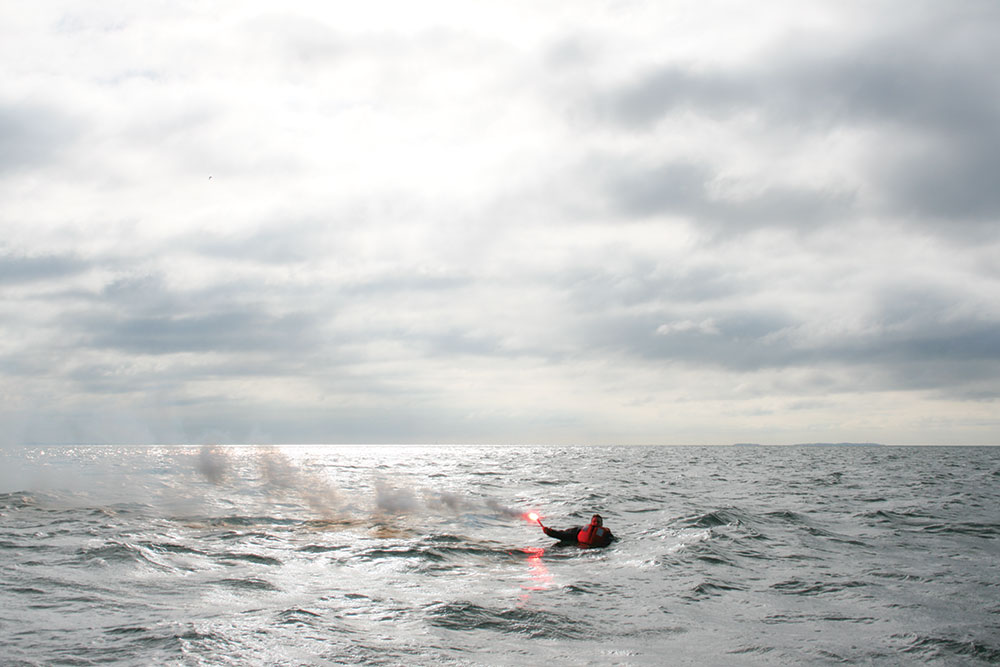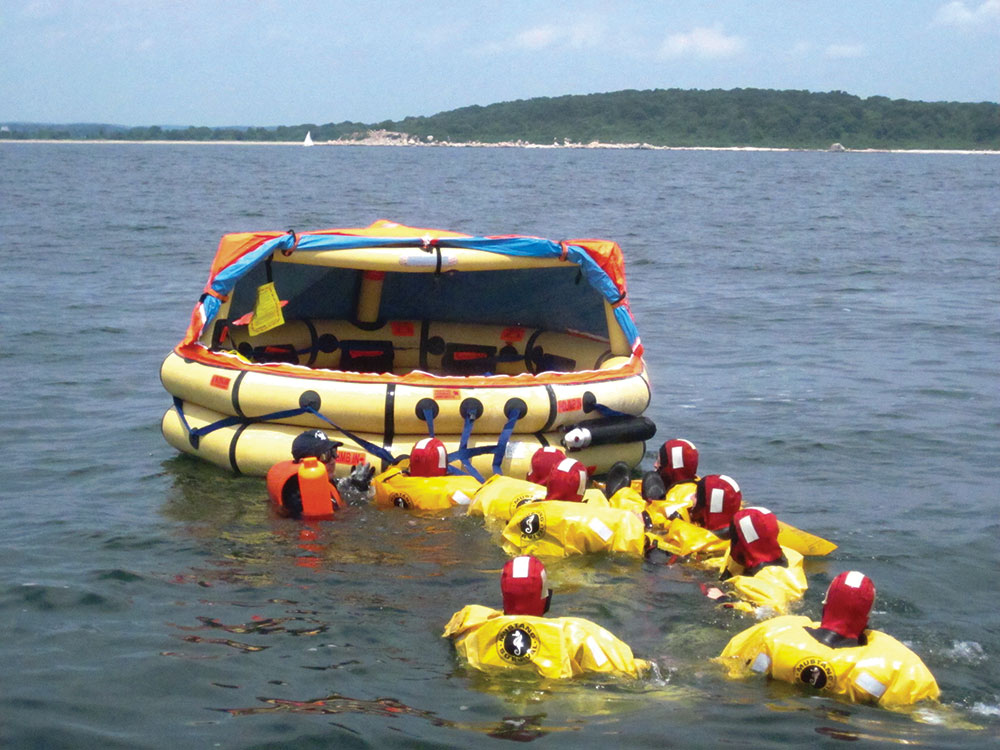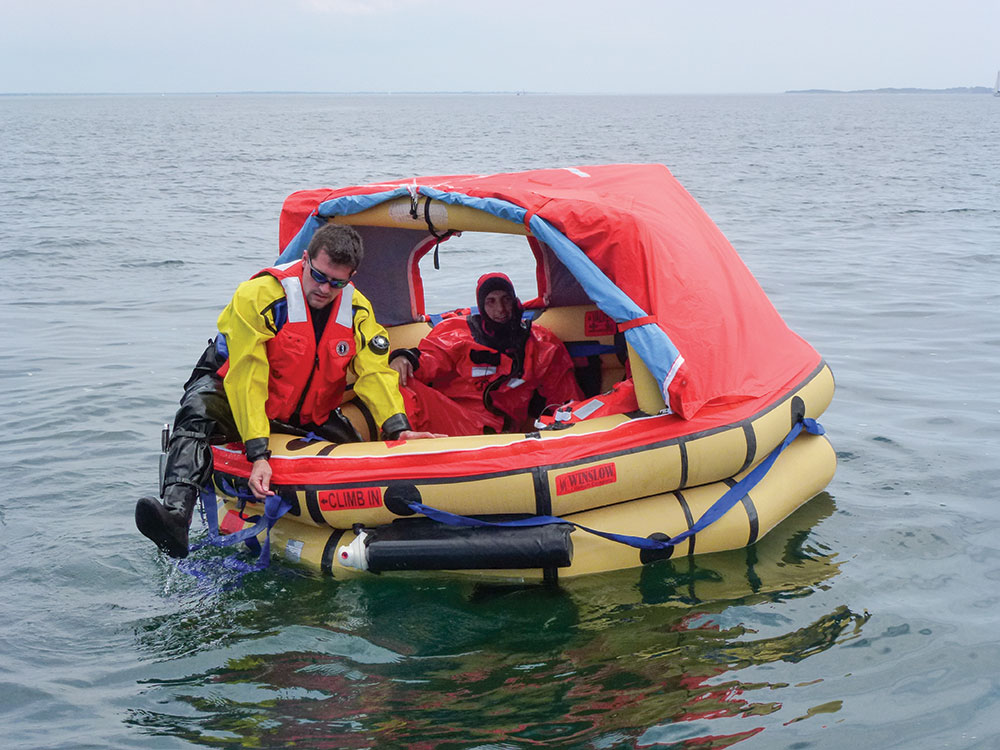A day in a life raft
What happens once you're in a life raft? A group of safety experts hunkers down in one for 24 hours to find out

Every sailor dreads the possibility of a sinking boat and having to make the call to abandon ship. The safety of the crew is paramount for every skipper, but without a plan, the evacuation can be just the beginning of the disaster. Knowing how to safely launch, board and operate a life raft can make all the difference. But there is no way to know what getting in and being in a life raft is like until you do it. That’s why several survival experts spent 24 hours in one off the shores of Fisher’s Island, New York.
The experiment was sponsored by Winslow Life Raft Co. of Lake Suzy, Florida, which was testing a new life raft model. Members of Survival Systems USA of Groton, Connecticut, who were seeking to gain insight that could be used in the school’s survival and safety curriculum, went along for the ride.
Twenty-four hours is not much of a test of physical and psychological fortitude. Any endurance test that has a finite length and a predetermined rescue time can’t hope to capture the true essence of endurance.
There are numerous factors to overcome in a real-world situation, and the testing didn’t account for injuries or extreme weather that can occur in a real life disaster. But what we learned were some practical ideas that may help those stranded at sea achieve valuable hours of survival time, and techniques that can sustain comfort and morale.
The first major issue to arise was simple boredom, which can take effect rather quickly and shouldn’t be taken lightly. Whether staring onto an open ocean or a cold gray fog bank, surviving gets tiresome and monotonous quite quickly. Stashing a deck of playing cards in your emergency kit is an excellent idea. Keeping a log book or just pen and paper to jot down thoughts or to maintain a log is also an excellent boredom mitigation device.
Comfort may have been the most critical factor in survival. One of the features in the Winslow ReversaSmart 14-man raft is a fully adjustable canopy, which allows you to create your own comfort level. During rain or a heavy sea state, the canopy can be completely closed to the elements. However, having the ability of different configurations allows air flow and sun protection at the same time. During the heat of the day this became essential.
Many life rafts have only a single opening for the entry, which can cause several problems. One is the lack of air flow, but equally limiting is the lack of additional access points for bodily functions. If a survivor in the back of the raft has to vomit, he would be forced to crawl over the other survivors until they reach the front of the raft. This can also be a factor for bathroom breaks. Even with full access around the raft that was tested, every time a member had to urinate it caused motion, disturbance and jostling. With only a single port, this activity could affect morale and increase the likelihood of conflict, especially if survivors were injured. And with only one opening, those stuck in the back of the raft will be hot and far more likely to suffer the effects of seasickness than those with the ability to catch a breeze at the opening. It’s important when shopping for life rafts to find one with more than one opening.
During the test there were seven of us in a life raft designed for 14 people, but the participants were still quite crowded and could not all be in the same position with legs facing the center of the raft at one time. Most commercially available rafts are built with a 50% overfill capacity, which means that as many as 21 people should have been able to fit in this model of raft. Even at the limit of 14, it would have been extremely difficult to do anything more than scrunch into a fetal position. With seven of us aboard, simply getting into a comfortable position to sleep or to sit wasn’t easy with the raft at half capacity.

Get comfy
Comfort raises morale. Sponges were found to be handy to have for several reasons. Most rafts are now equipped with several sponges. It is important to designate a sponge for bailing and a sponge for potable water collection. The ability to soak up every last drop of water inside the raft is not only a comfort issue but is also necessary to prevent possible hypothermia. A raft with a wet bottom can pull heat away from a survivor at a rapid rate, 25 times faster than air. A survivor who makes it into a raft with just shorts or just in their underwear will be battling hypothermia in a wet raft even in warm tropical waters.
During the test, hypothermia quickly became an issue even though temperatures were above 80 degrees during the day, because as soon as the sun went down, the raft became a very cold and wet place. The crew wore full immersion suits. It would seem that with an insulated immersion suit in the middle of summer, even with a sea temp of 63 degrees, participants would have been protected, but they were still at the mercy of the elements. All of us quickly became cold when the sun set. Though the suits offered protection, dew, sweat, rain and condensation were enough to bring several participants to the first stage of hypothermia.
This can be a difficult problem to rectify, as full-immersion suits may be impractical for some crews, and are often not donned during a real emergency. However, warmth, even in tropical waters is essential. Some barrier between you and the surface water is also essential. Many life raft kits come with a mylar or plastic blanket, and it is recommended that you supplement your kit with at least one for every crew member, and more if suitable space can be found. Without some sort of insulating material, you will quickly be miserable, and in danger of hypothermia. Some styles have an inflatable floor that helps keep survivors out of direct contact with the surface water. But no design will keep survivors completely off the surface. More survivors also mean more weight and increased contact through the rubber floor with the water. Even with the protection of the floor and a top of the line immersion suit, the water quickly pulled heat from us.

Water, water everywhere
The water collection sponge was also a vital component to staying hydrated. If the raft doesn’t have a desalinator, or if the device malfunctions, sponges can collect a surprising amount of potable water. The condensation and dew collected could mean the difference between rescue or recovery. Make sure your raft is equipped with sponges.
Some rafts are designed to allow for the ballast bags to be pulled out of the water and tied to the raft. This allows the raft to move with the wind more freely without the drag of the bags. This could be useful if the wind was blowing toward shore and the sea state is mild. The life raft we tested allows these bags to be pulled up into the raft in a more convenient manner. Prior systems had the ballast bags directly glued to the bottom of the raft, making drag a factor even when tied in the up position. Look for designs having bags that are fully separate from the raft allowing for zero drag when the bag is retracted. If the bags can be fully removed, they can be used for water collection, sun protection, storage, bailing, a waste bucket, or any creative use survivors conceive of. Items with multiple uses are a vital asset on any raft or in any emergency scenario. Remember that ballast bags play an important role in keeping the raft stable in rough conditions.
Biting insects may not sound like a detriment to survival, but during this test, the life raft was a mile offshore and insects quickly inundated the raft. Flying insects have been documented hundreds of miles from shore so even bluewater sailors should be prepared. The best solution would be a combination sunscreen and repellent in one product. The raft was packed with sunscreen wipes that took up little space, but a product that combined an insect repellent would have brought huge relief.
Life rafts must have a desalinator or water purifier along with another method of collecting drinking water. This is not a piece of equipment that can be sacrificed to save weight as potable water is critical for survival. It’s a good idea to familiarize yourself with the water collection devices that are packed in your raft. The system that was tested worked fine until water had to be doled out. The mouth of the bag was too big and too cumbersome so precious amounts of water were spilled. A device with a spigot would have been an improvement. A collapsible cup would also be of use.
During our test, water was poured into a small plastic bag that held emergency kit components and again, precious drops were lost in the transfer from bag to mouth. It wasn’t a big deal during a 24-hour test, but it would be a serious issue in a real emergency where sailors must spend days in a raft. Survival Systems USA recommends in its classes that survivors should not eat and limit water consumption in the first 24 hours of an emergency. Rescue more often than not occurs during this period and it is best to avoid what occurred in the test raft with a revolving parade of sailors having to excrete waste. The testers ate and drank in order to test equipment and validate procedures.
Shine a light on it
Useful and adequate lighting is essential. During this test, the raft was almost run over by a small whaler in the wee hours of the morning despite a safety boat being anchored less than a quarter of a mile away. The boat never had a chance to see the raft in the heavy fog and without quick action by a member of the crew, there would have been a collision. Lighting can also aid in rescue; you want to be seen and the more lights the better. Do not rely on the water-activated lights to work. They are notoriously fickle and when they work, they often illuminate for only a short time. Water-activated lights can be pulled from the water during the day, extending their life and enhancing the chances of rescue.
The items tested included the food, compass, safety knife and fishing kit. When shopping for a life raft make sure you know what is included in your life raft’s kit, and add additional items before it is packed. It’s a good idea to schedule a practice session for your crew to make sure everyone knows how to use it. Using a life raft repair kit while in your garage or on the dock instead of in 30-foot seas may save the lives of you and your crew. Would you rather know how to shoot off the flares in your emergency kit under sunny skies, or in the dark with sea spray pelting your eyes in a 50-knot gale? It’s also important for everyone aboard to know how to work your electronics, epirbs, GPS units and other emergency devices.
The best advice is to make sure your life raft and its emergency kit are stocked with everything to make you as comfortable as possible. The addition of a few ounces of emergency equipment won’t affect your race, but it may very well save your life and the lives of your crew. All of us in the raft were stunned at how quickly we became miserable and how quickly the morale wavered. And that was with the knowledge that rescue was coming. The more comfortable you are in any emergency, the more likely you are to survive.
Life raft survival tips
• Don’t wait until you are in an emergency to learn how to use your life raft. Take the time before you sail to familiarize yourself and the crew with the contents of the raft.
• Survival often depends on how comfortable you are. Augment your life raft’s content with anything that can be of comfort or increase safety.
• Hypothermia is the biggest factor working against your physical survival, and knowing how to deploy an immersion suit and keeping the life raft bone dry is essential.
• Know the four phases of survival: Protection (keep protected and dry), first aid (not much outside of direct pressure for bleeding and keeping broken bones in a position of comfort can be done, but psychological first aid can be addressed), signaling devices (don’t wait until you hear an engine to figure out how to deploy these devices; know how to use them), and endurance (this is difficult to teach, but make sure you and your crew understand how mentally devastating being in a water emergency actually is as the psychological component of survival can ebb and flow from one person to another).
• Assign duties to survivors—passing out seasickness pills, assign the most clear-headed survivor to be in charge of signaling devices and assign watch shifts.
• Avoid eating and limit fluids in the first 24 hours. You have to get rid of that waste and especially if you have an injured person in the raft, movement disrupts everyone’s comfort.--B.R.

Comments